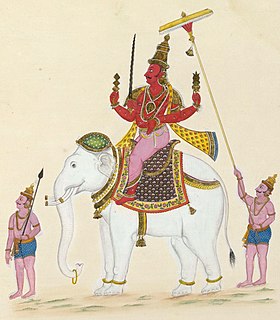
Indra is an ancient Vedic deity in Hinduism. He is the king of Svarga (Heaven) and the Devas (gods). He is associated with lightning, thunder, storms, rains, river flows and war. Indra's mythology and powers are similar to other Indo-European deities such as Jupiter, Perun, Perkūnas, Zalmoxis, Taranis, Zeus, and Thor, suggesting a common origin in Proto-Indo-European mythology.

In Hinduism, Ahalya also known as Ahilya, is the wife of the sage Gautama Maharishi. Many Hindu scriptures say that she was seduced by Indra, cursed by her husband for infidelity, and liberated from the curse by Rama.

Brahmarshi Vishvamitra is one of the most venerated rishis or sages of ancient India. A near-divine being, he is also credited as the author of most of Mandala 3 of the Rigveda, including Gayatri Mantra. The Puranas mention that only 24 rishis since antiquity have understood the whole meaning of—and thus wielded the whole power of—Gayatri Mantra. Vishvamitra is supposed to be the first, and Yajnavalkya the last.

In Hindu mythology, Menaka is considered one of the most beautiful of the heavenly Apsaras.

Kamakhya is an important Hindu Tantric goddess of desire that evolved in Kamarupa in Assam. She is worshiped as Siddha Kubjika, and is also identified as Kali and Maha Tripura Sundari. According to the Tantric texts that are the basis for her worship at the Kamakhya temple, a temple in the Kamrup district of Assam. The earlier manifest of the goddess sanctified at the Garo hills is destroyed, although the Vatsayana priests are said to have carried away the manifest of the goddess to the Hindu kingdom in Kashmir and later sanctified in a remote hill forest in Himachal Pradesh. She resides at the presently 10th/11th century Kamakhya Temple rebuilt in 1565 CE. The temple is primary amongst the 51 Shakti Peethas related to the sect that follows Sati, and remains one of the most important Shakta temples.

According to Hinduism, Yayāti was a Chandravanshi king. He was one of the ancestors of Pandavas and Yaduvanshis. He was the son of King Nahusha and his wife Ashokasundari, daughter of Shiva and Parvati, however, early sources state that Virajas, daughter of the Pitris, was the mother of Yayati. He had five brothers: Yati, Samyati, Ayati, Viyati and Kriti. Yayāti had conquered the whole world and was the Chakravartin Samrat. He married Devayani and took Sharmishtha, daughter of king Vrishparva and maid of Devayani to his empire. Devayani was the daughter of Shukracharya, the priest of the Asuras. Later he copulates with Sharmistha. After hearing of his relationship with Sharmishtha, Devayani complains to her father Shukracharya, who in turn curses Yayāti to old age in the prime of life, but later allows him to exchange it with his son, Puru. His story finds mention in the Mahabharata-Adi Parva, in the Bhagavata Purana & also in the Matsya Purana.
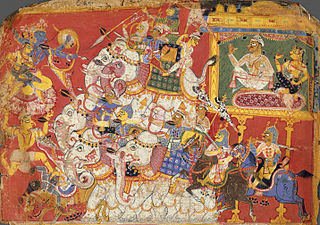
Naraka, also known as Narakasura, was a mythical asura king, the legendary progenitor of all three dynasties of Pragjyotisha-Kamarupa, and the founding ruler of the legendary Bhauma dynasty of Pragjyotisha. Though the myths about Naraka are first mentioned in the Mahabharata, later texts embellish them. According to later post-Vedic texts such as the Brahma Purana and Vishnu Purana, he was the son of Bhudevi, fathered either by the Varaha incarnation of Vishnu or Hiranyaksha. He is claimed as one who established Pragjyotisha. He was killed by Krishna and Satyabhama. His son Bhagadatta—of Mahabharata fame—succeeded him.

Hindu mythological wars are the wars described in the Hindu texts of ancient India. These wars depicted both mortals of great prowess as well as deities and supernatural beings, often wielding supernatural weapons of great power. Hindu teachings prescribe war as the final option, to be employed only after all peaceful methods are exhausted. Participation in righteous war, or dharmayuddha, was said to be honourable and was a principal duty of the Kshatriya or warrior caste, and victory in such wars was regarded as a matter of honour.
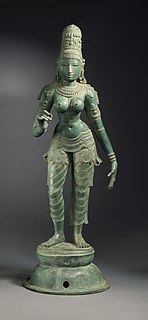
Satyabhama, also known as Satrajiti, is a Hindu goddess and the third queen-consort of the Hindu god Krishna, the eighth avatar of the god Vishnu. Satyabhama is described as the avatar of Bhudevi, the earth-goddess. She aided Krishna in defeating the demon Narakasura.

Tilottama, is an Apsara described in Hindu mythology. "Tila" is the Sanskrit word for sesame seed or a bit and "uttama" means better or higher. Tilottama, therefore, means the being whose smallest particle is the finest or one who is composed of the finest and highest qualities.

In Hindu mythology, Nahusha was a king of the Aila dynasty and the 3,698,256th Indra (position). He was the son of Āyu, the eldest son of Pururavas, and Prabha, the daughter of Svarbhānu. Nahusha is also mentioned often in the Rigveda, starting in Mandala 1. Nahusha reigned from Pratishthana. He married Viraja, the daughter of the Pitrs. They had six or seven sons, according to different Puranas. His eldest son Yati became a muni (ascetic). He was succeeded by his second son Yayati. In another and more popular variation of his story, he is said to have married Ashokasundari, the goddess who the daughter of Shiva and Parvati and she is said to have given birth to Yayati and a hundred daughters of Nahusha.

Bhumi, also known as Bhudevi and Vasundhara, is the Hindu goddess representing the Earth. She is the consort of Varaha, an avatar of the god Vishnu, and thus she is sometimes referred as Varahi. She is mentioned as the mother of Narakasura and Mangala. Goddess Sita is referred to as Bhumi's daughter.
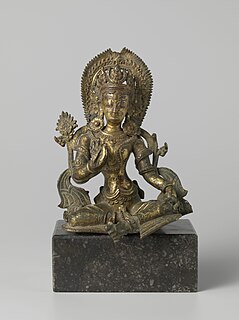
Indrani, also known as Shachi, is a Hindu goddess. Described as the daughter of the asura Puloman, she is the wife of Indra and the queen of the devas (gods).
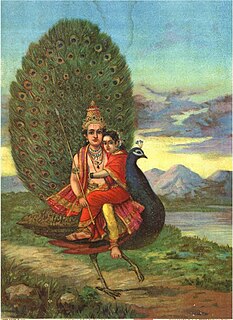
Devasena is a Hindu goddess and the consort of the god Kartikeya. She is known as Devayanai, Deivanai or Deivayanai in South-Indian texts. Her name is also spelled as Teyvanai or Tevayanai.

Ashtabharya(s) or Ashta-bharya(s) is the group of eight principal queen-consorts of Hindu god Krishna, an avatar of the god Vishnu and the king of Dwarka - in the Dvapara Yuga (epoch). The most popular list, found in the Bhagavata Purana, includes: Rukmini, Satyabhama, Jambavati, Kalindi, Mitravinda, Nagnajiti, Bhadra and Lakshmana. Variations exist in the Vishnu Purana and the Harivamsa, which includes queens called Madri or Rohini, instead of Bhadra. Most of them are princesses.

Besides eight principal queens (Ashtabharya), the Hindu god Krishna, an avatar of the god Vishnu and the king of Dwarka, is described to have many unnamed junior wives. Their number is mentioned as 16,000 or 16,100 in different scriptures.
In Hindu mythology, Jayanta, is the son of Indra, the king of the gods (devas) and his wife Shachi (Indrani). He resides in Svarga, the Hindu heaven, governed by Indra. He has a sister called Jayanti. He appears in various Hindu scriptures as fighting wars on behalf of the gods and his father. Jayanta also appears in the epic Ramayana and other lore, in which he disguises himself as a crow.
Rambaiyin Kaadhal is a 1939 Indian, Tamil language mythological film directed by B. N. Rao. The film featured K. Sarangkapani and K. L. V. Vasantha in the lead roles. The film has an alternate title Yathbhavishyan.
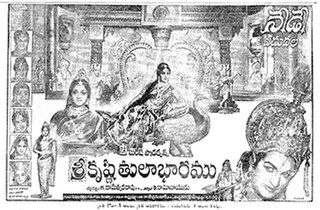
Sri Krishna Tulabharam is a 1966 Indian Telugu-language Hindu mythological film, produced by D. Ramanaidu under the Suresh Productions banner and directed by Kamalakara Kameswara Rao. It stars N. T. Rama Rao, Anjali Devi and Jamuna with music composed by Pendyala Nageswara Rao.
















